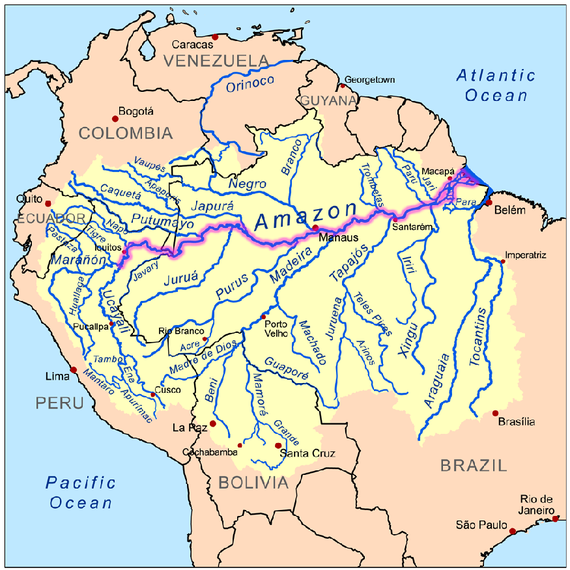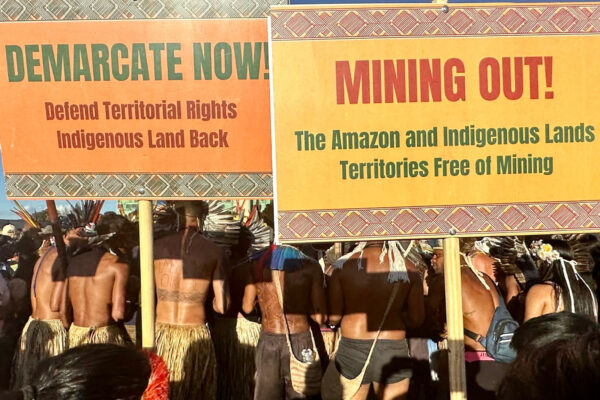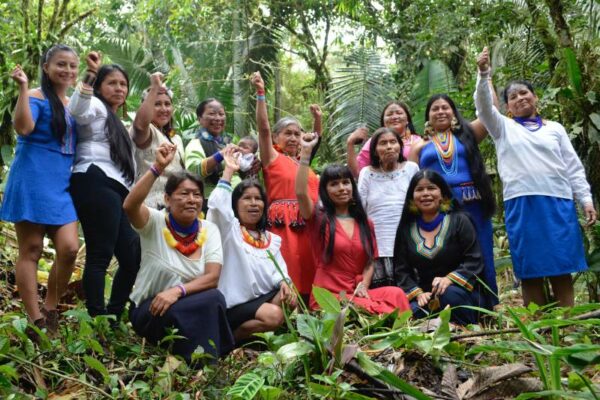Ruth Buendía Mestoquiari has built her career, and staked the fate of her people, on the law.
But she doesn’t have a law degree. In fact, she didn’t even start elementary school until she was a teenager and didn’t finish high school until age 25. While her peers went to class, she spent her childhood in the 1980s and 90s shuttling between her native village of Cutivireni, the town of Satipo, and the city of Lima, as Peru’s two-decade civil war devastated her community and claimed her father, who was killed in the violence when Buendía was only 12.
What Buendía does have is five children, all 18 and younger, and a “wonderful husband.” She has the distinction of being the first female president of CARE, an organization representing roughly 10,000 indigenous Asháninka who live along the banks of the Ene River in the Peruvian Amazon. And she has a knack for blocking massive hydroelectric dams, having thwarted not one but two planned projects that she believed would displace the Asháninka and destroy the ancestral lands they depend on for their livelihoods. It’s a threat she characterizes as “economic terrorism,” in an allusion to the armed terrorism she experienced during the civil war.
Through it all, she’s managed to redeem what we’ve come to consider something of a dark art: the lawsuit.
The 37-year-old, who received a Goldman Environmental Prize this week for her efforts, has employed several tactics in her duels with the dams, which were first proposed as part of an energy agreement between Peru and Brazil in 2010. She’s marshaled technology, using a laptop and computer simulation to show constituents how the dams would flood the Ene River Valley. She’s courted media attention, established international partnerships, and mobilized her people in regional assemblies.
But above all, she’s insisted, again and again, that she has the law on her side – specifically an International Labor Organization treaty that Peru ratified in 1994 and national legislation that the country passed in 2011. Both require the government to consult with indigenous communities before launching development projects – be they infrastructure initiatives or mining concessions – that will affect them. The concept is known as “prior consultation.”
Buendía’s primary argument isn’t that the dams are illegal per se, but rather that Peruvian authorities must first secure her people’s consent about how the projects should proceed – if, that is, there are grounds to proceed in the first place. By filing lawsuits in Peruvian courts with the help of legal advisors and making her case to bodies like the D.C.-based Inter-American Commission on Human Rights, Buendía has pressured Peruvian officials and Brazilian companies to halt the construction of the Pakitzapango and Tambo-40 dams – at least for now.

In prioritizing legal strategies over others, Buendía’s key insight is to fight fire with fire. After all, the proposed dams are a product of a compact between governments – a 50-year energy agreement that Peru and Brazil struck in 2010. The plan was for Brazilian corporations to dam rivers in the Amazon rainforest in Peru and produce up to 7,200 megawatts of hydropower.
Peru’s leaders trumpeted the numerous benefits the dams would bring: Brazilian companies would be investing heavily in one of the country’s few energy sources – its rivers – and leveraging a renewable energy source at that. The projects would create thousands of jobs for Peruvians and bring affordable energy to rural areas. But under the deal, most of the power generated would have been exported to Brazil. And the Asháninka, along with several studies by conservation groups, have warned of the grave environmental and social impacts of the plants. The dams, for instance, could flood the surrounding jungle, submerging arable land, threatening water quality, endangering the forest’s biodiversity and the rivers’ fish populations, and forcing Asháninka to migrate.
“They think we’re going to break windows and protest like in Conga, but we aren’t,” Buendía told The New York Times in 2012, in reference to fierce demonstrations in northern Peru against a gold-mine project. “Just as they do to us with legal documents we are going to do to them.”
International treaties and national laws have granted the Asháninka rights, she reasons. Now it’s up to the Asháninka to apply the law.
So far, Buendía has had tremendous success – especially considering that she and her scrappy organization (CARE had no office, and one typewriter, when she took the helm in 2005) have bested governments and giant multinational companies with a lot of money on the line.
But her approach has its drawbacks as well. To begin with, national and international legal frameworks don’t always accommodate indigenous people’s expansive definition of their territory, which perhaps explains why Buendía is still pressing the Peruvian government to establish land rights for all the Asháninka communities she represents. CARE’s 2015 strategic plan describes the land in terms that are as much spiritual as economic: “The Asháninka of the River Ene as a cultural group have their own forms of defining their things, so the word Territory is alive and consists of a whole in its integrity, it helps us live or dwell, feed ourselves, heal ourselves, make our homes, and within it we are accustomed to leading a quiet life without suffering.”
The legal process is also byzantine, fitful, and protracted. When I spoke with Buendía by phone earlier this month, she didn’t sound like a woman who had faced off with two mega-dams and won. She sounded like a woman who had faced off with two mega-dams and made it to the next court hearing, with the construction of the dams an ever-present prospect.
“We are still waiting, we are still waiting,” she told me, in reference to her habeas data lawsuit for information on the Pakitzapango project (a Peruvian judge ruled that Peru’s Ministry of Energy and Mines should hand over corporate documents associated with the planned dam to the Asháninka, but the ministry has yet to comply with the order).
The ministry continues to believe in the economic potential of the dams but simply hasn’t found new companies to finance and build them, she explained, adding, “We are staying alert.”
In recent years, indigenous peoples around the world, and particularly in Latin America, have turned to litigation to defend their rights. But Buendía’s story speaks as much to the limits as to the potential of “prior consultation” as a guarantor of those rights. As Almut Schilling-Vacaflor and Riccarda Flemmer recently asserted in a paper for the German Institute of Global and Area Studies, effective consultations between governments and indigenous groups on development projects depend on how the legal principle is carried out in practice. Are state institutions impartial and capable of balancing diverse interests? Who holds the real decision-making power: the government, the corporation, or the consulted group? Are the agreements these parties reach binding?
With these questions left unanswered, “prior consultation” hasn’t realized its promise in Peru, where indigenous uprisings over natural-resource extraction have devolved into deadly violence in the past. Peru’s president claimed that the nation’s 2011 “prior consultation” legislation – the first of its kind in Latin America – “would give voice to the needs of the indigenous communities of the country and thus contribute to greater social harmony,” Schilling-Vacaflor and Flemmer write. “Yet the current trend actually points in the opposite direction: social conflicts in Peru increased in number from 217 in June 2011 to 247 in June 2012, the majority of which were classified as socioenvironmental conflicts related to the mining sector.”
The Peruvian authorities, in fact, didn’t put “prior consultation” into practice until early 2013, and have at times appeared to sideline the process as they seek investment in natural-resource projects. Last May, Ivan Lanegra, the government official in charge of implementing the “prior consultation” law, resigned in apparent protest over the government’s decision to not apply the legislation to the Quechua-speaking communities in the Andes, the site of several potential mining projects.
At issue was a fraught question at the center of the “prior consultation” debate, and the larger debate in the region over how to pursue natural-resource wealth while remedying structural inequality that has festered since the colonial era: Which groups should the government consider “indigenous”? Lanegra argued that the Quechua, like groups in the Peruvian Amazon, were indigenous, while the Energy and Mines minister argued that they were not. The Energy and Mines minister prevailed.
“Dealing with big companies is not easy,” Buendía says in the UN video below, which profiles female indigenous leaders in Peru. “They have money and they pay so we get divided…. Without land the indigenous people are nothing and nobody.”
As for that law degree, it’s now in reach for Buendía. She recently suspended her studies when the demands of motherhood and her job became too much to bear. But if all goes well, she plans to finish up the degree at a university in Satipo later this year. Just in time, perhaps, for the next round of court cases.













